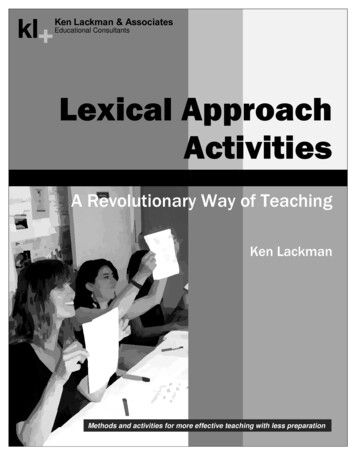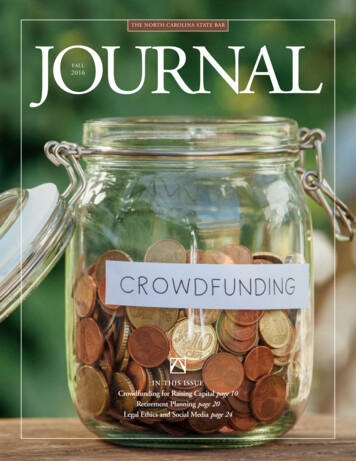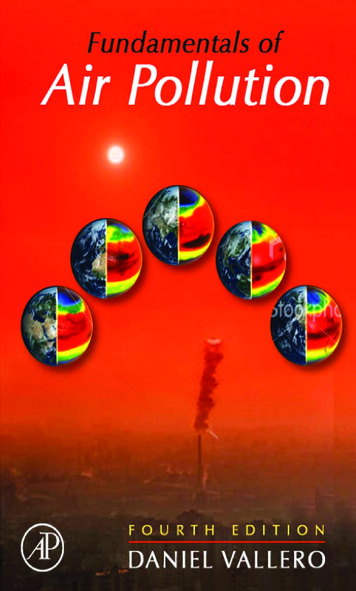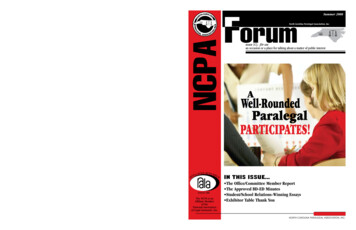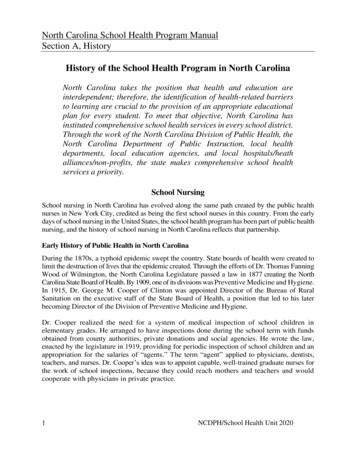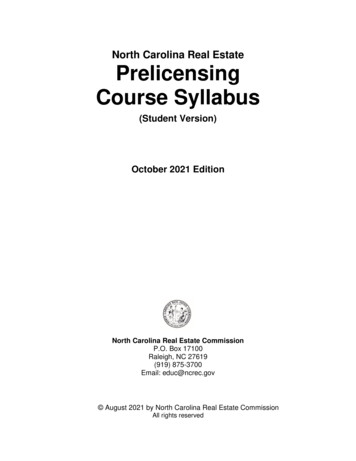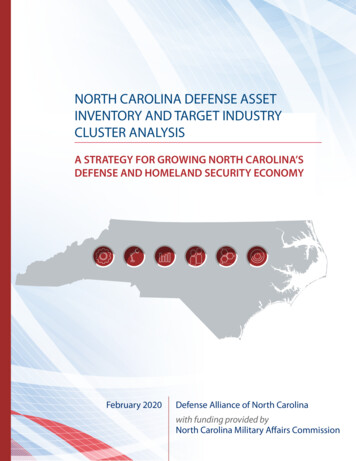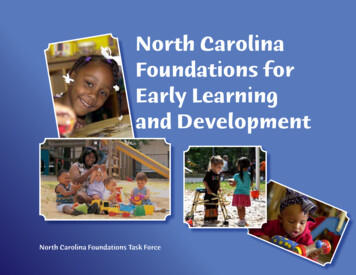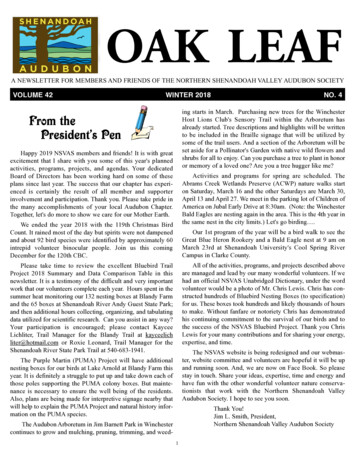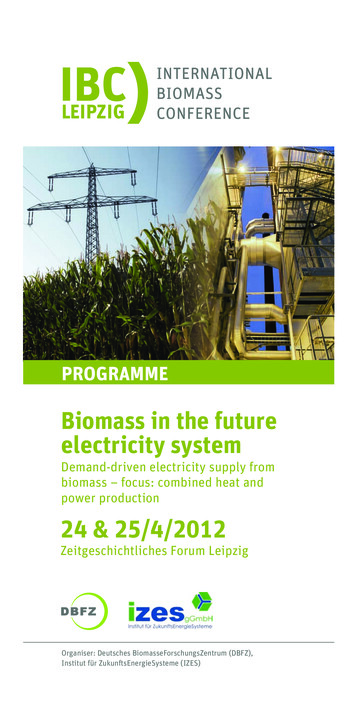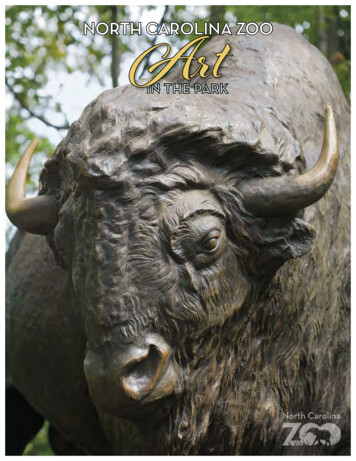
Transcription
NORTH CAROLINA ZOO
Making Connections to NatureThe North Carolina Zoo’s art collection magnifiesnature: its beauty and complexity. Zoo art evokesemotions: It inspires people to care about andpreserve the natural world.The Zoo’s collection calls out to everyone. Itincorporates diverse media and broadcasts layeredmessages that break through cultural barriers andreach across generations. Different styles, differentartists and different forms invite visitors to embarkon unique journeys of personal discovery andexploration.These artists’ works tantalize visitors’ senses—moving them with colors, shapes, sounds,movements and textures. Works spring up aroundthe Park, all aligned to awaken curiosity, challengeperceptions and evoke new ideas about nature’sunyielding beauty and unending variety.The works emulate nature’s diversity. They emergeas smooth bronzes, recorded stories, texturedceramics, colorful paintings, lighthearted sketches,complex murals and lively music. Together theycomplement one another, revealing nature’s secretsto gently expose and explain the bonds that linkhuman survival to the living organisms that cleanand sustain the air, the water and the earth we allneed to survive.North Carolina Zoo4401 Zoo Parkway,Asheboro, NC 27205www.nczoo.org1.800.488.0444NC Zoo Society4403 Zoo Parkway,Asheboro, NC 27205www.nczoo.com1.888.244.3736The North Carolina Zoo is a programof the Department of Natural andCultural Reources.This symbol indicates the artworks that offer tactile andauditory experiences for our visually impaired visitors.2Art in the Park NCZoo.org
LOCATION: North America: Entrance11The Elephant Group (1998)Peter WoytukBronzeSponsored by Bob and Bonnie MeekerThe Zoo’s largest sculpture greets visitors at the main entrance.Designed to signify arrival and generate feelings of excitementand anticipation, this arrangement of life-sized elephantsculptures creates an environment where the negative space andthe relationship between pieces is as important as the individualsculptures themselves. Distilled into stylized forms, the sculptureresults in a rhythmic interplay of concave and convex masses.2Spalanzani’s Generator (2006)Pete BeemanPainted Steel, Solar Panel and BicyclesSponsored by Bob and Bonnie MeekerThe artist was able to marry a strong visual aesthetic, aparticipatory, kinetic function and two alternative power sourcesin Spalanzani’s Generator. The theme of alternative energy isexpressed through the motion of two giant “arms,” powered bya solar panel and people peddling three bicycles. The sculpture’slink to “green” technology and the sustainable use of resourcessupports the Zoo’s conservation mission. The name of thesculpture comes from a 19th century opera, the Tales of Hoffman,in which a mad scientist named Spalanzani dupes the hero intofalling in love with a robot woman.323The Green Dragonfly (2011)Mike DurhamRecycled MaterialsMade possible through a gift to the NC Zoo Society byPamela Potter and De Potter4Set in a pond designed to filter oil and water run-off fromthe parking lots, The Green Dragonfly reflects the on Zoo’scommitment to protect its green spaces.4Sum of the Parts (1998)Dempsey CalhounPainted Steel and FiberglassSponsored by Bob and Bonnie MeekerSum of the Parts celebrates the diversity of life on earth. Most ofthe 20 cubes in Sum are reminiscent of a child’s colorful alphabetblocks, but three are slightly removed from the rest. Tworepresent endangered species and the third symbolizes speciesthat are already extinct.Art in the Park NCZoo.org3
5LOCATION: North America:Cypress Swamp through Marsh5Catamount (2002)Bart WalterBronzeSponsored by the James C. Raulston Estate67Catamount is another name for a puma or cougar — a large,long-tailed, unspotted, tawny colored cat. The eastern cougarwas known to have lived in North Carolina and 20 other easternstates from Maine to South Carolina and from Tennessee toMichigan.6Stalking Little Blue Heron (2005)David H. TurnerBronzeSponsored by Watsco, Inc. in honor of Jeff FilesThis sculpture is an accurate depiction of the way the little blueheron moves while hunting for food in a watery habitat. Thissmall bird is found mostly in the southeastern United Statesin swamps, estuaries, rivers, ponds and lakes. Habitat loss andchanges in local water systems are the most serious threats tothis animal.87Preening Heron (2005)David H. TurnerBronzeSponsored by Watsco, Inc. in honor of Jeff Files8Billy Goats Gruff (2012)Bob CoffeeBronzeMade possible through the NC Zoo Society9Three Billy Goats Gruff is inspired by a Norwegian fairy tale.Look closely and you’ll find the troll under the bridge.9Cattail Gate (1998)Jim GallucciSteel and BrassSponsored by Donald Morrison as a living memorial to hiswife, Cynthia D. Morrison“We must save the poetry that swims in creeks and nests on mountaincliffs and leaps from jungle vines. Our greatest legacy will be to passalong that living, breathing poetry to future generations.”—Michael Beadle4Art in the Park NCZoo.org
1010 Zoological Egg Rest (1995)Horace L. FarloweGeorgia MarbleMade possible through the NC “Art Works for StateBuildings” ProgramThe egg, the essential symbol for life, is the form on which thisgraceful marble sculpture is based. The large smooth, elegant eggshave a strong visual impact and tactile quality. Children often siton them or lay across them. After all, it’s not often one can hug aturtle egg.11 Murmuration (2013)Mike RoigStainless Steel & Recycled SteelSponsored by Bob and Bonnie MeekerMurmuration is a kinetic sculpture that suggestsnatural phenomena like the movement of windand the flight of starlings.121112 Lisa’s Dragonfly (2011)Mike DurhamRecycled MaterialsMade possible through a gift to the NCZoo Society by De Potter, in memoryof Lisa Cassidy, a member of the ZooHorticulture Staff.LOCATION: North America: Rocky Coast13 Bald Eagle with Salmon (1998)David H. TurnerBronzeSponsored by the Independent Insurance Agentsof North Carolina141314 Arctic Turns (2003)Rufus SederLenticular Glass TilesSponsored by Bob and Bonnie MeekerMade of glass tiles, Arctic Turns features nine murals with imagesthat appear to move as the viewer walks by them. The muralsdepict a variety of animal life within marine environments.They also illustrate ways in which people have historically beenconnected to the world’s oceans and hint at how human activitieshave affected ocean health. Oil rigs, a fishing trawler and Eskimohunters are placed in the various scenes of the murals.Art in the Park NCZoo.org5
15 Little Sea Dog (2015)Chris GabrielBronzeThis sculpture was made possible through a gift to the NCZoo Society from Bob and Bonnie Meeker151616 Polar Bear (2013)Chris GabrielBronzeThis sculpture was made possible through a gift to the NCZoo Society in memory of Thomas W. Young by his lovingwife, Frances.17 Arctic Fox (1999)J. Tucker Bailey17BronzeSponsored by Muriel J. Fox in memory of her husband,William Howard FoxLOCATION: North America:Kidzone and Garden Friends Playground18 Hummingbird Garden (1996)Jim Gallucci1819Painted SteelSponsored by Emily B. Ettinger in memory of her husband,Richard E. Ettinger19 Follow the Pollen Path (2002)De PotterGlazed Ceramic TilesSponsored by First National Bank & Trust Companyand Zoo Walk 2001This tile mural, situated at the entrance to the Garden Friendsplayground, ties into the playground’s theme of beneficial insectsin the garden. The “pollen path” is the route taken by honeybees when they fly out from their hive to forage for nectar andpollen. In their search for food, the bees pollinate the bloomsthat they visit. Orchards, farm crops, our home gardens, and mostflowering plants depend upon honey bees and many other insectsfor pollination.6Art in the Park NCZoo.org
20LOCATION: North America:Streamside through Black Bear20 River Frolic (2001)Carl ReguttiBronzeDedicated to Jefferson D. Bulla, II M.D. by Lisa and BillyPennington, Jeff and Toni Bulla and Ross BullaNorth American otters are fast, agile swimmers propellingthemselves through the water by kicking webbed rear feet andmoving their bodies from side to side, like a snake. Even thoughthey can see underwater they have whiskers that help them locateprey when the water is murky. Their diet consists mainly of nongame fish, crayfish, insects and small mammals. In this gracefulsculpture the artist captures a “dance” of two otters as they goafter a fish.2121 Streamlines (2004)Stacy LevyAsphalt, Paint, Glass, Incised Granite DiscsMade possible by a grant from the NC Arts Council tothe Zoo’s Visiting Artist ProgramAs the flow of water is interrupted by the bends in a creekor rocks in a channel, it is twisted and curled into beautifulscrolling spirals called streamlines. This artwork diagramsthe hydrolic flow which would be present if this path werea stream. The small medallions inset into the path representthe variety of micro-organisms found in a healthy stream.22 “Why Bear Why?” (2008)22Cynthia MitchellStory, Recording & BookMade possible through the NCZoo’s Visiting Artist ProgramTravel to the ocean and the shoresof Ocracoke Island. There Hallie andher father meet up with three singingsandpipers and a very unexpectedvisitor. Taking our cue from Hallie— there’s no telling what wonders,mysteries and surprises we can meetup with when we pay attention to theworld around us!Art in the Park NCZoo.org7
23LOCATION: North America:Prairie through Honey Bee23 Black Dog (2001)Donna DobberfuhlBronzeSponsored by Bob and Bonnie Meeker24“When I start a sculpture such as this I always research mysubject thoroughly, finding out about the essence of thespecies, the physiology and . the folklore. When reviewingthe history of the bison and the early attempts at conservation,I found the story of one most interesting animal, ‘Black Dog,’from all descriptions one of the largest bulls documented.He became my focus. The bronze sculpture of Black Dog isthe manifestation of my vision of a great historical figure.Conservation efforts have saved the bison and I hope that theimage that I have captured in bronze brings a smile and a senseof ownership to this magnificent creature of the plains.”24 Uwharrie Vision (2003)Herb ParkerConcrete, Steel, Soil and PlantsSponsored by the family andfriends of Wescott Moser25A distant view of Harvey’s Ridge can beseen from the top of Uwharrie Vision, anearth works installation so well blendedinto the native landscape that it appearsto be a natural outcropping.25 Bear and Shaman (2012)Jonathan KingdonBronzeGift of the Family of Stephen A. Wainwright in Memoryof Ruth Palmer WainwrightBear & Shaman symbolizes the uneasy juxtaposition ofwilderness and people. The bear represents America’s vast spacesand the shaman alludes to humanity. Her tambourine standingfor the protective role of technology. The surprise on their faceshints at the uncertainties facing man and beast, nature andcivilization, as they try to adapt to each other.8Art in the Park NCZoo.org
2626 Stone that Stands in an Empty Sky (1997)Roger P. HalliganSteel and ConcreteMade possible through the NC Zoo’sVisiting Artist ProgramThe standing stone is a monument to the flocks of thousandsof Carolina parakeets that once swooped throughout NorthCarolina in the spring and festooned the tree tops with vibrantcolor. It is a memorial to a now extinct species.2727 Sonoran Snake (1993)Warren Mather & Nancy SelvageCeramic TilesSponsored by Mr. and Mrs. A. P. AndersonInto the body of the rattlesnake is a continuously modeledterrain of rocks, plants and animals. From the tip of the tail tothe distinctive triangular head of the western diamondback,desert animals roam by day and by night.28 Piedmont Totem (2012)Montgomery Community College Ceramics ClassCeramicsThrown and modeled to represent flora and fauna native to theZoo site, the ceramic rings (each a complete artwork) embodythe interdependence found in every aspect of nature. Organismsthat promote decay (the centipedes, fungi, beetles) and thingsunderwater (fish, tadpoles, water plants) are on the bottom. Inthe next layer the ground dwelling animals and plants can beseen (box turtle, beaver, trout lily, black snake, wild ginger, skunkand deer). Higher up on the totem are the butterflies, squirrels,oak leaves and acorns. A raccoon peeps out of a hole in a tree,bats hang among the sugar maple and muscadine vines. In thehighest branches a woodpecker can be discovered along with agreat horned owl, a red-tailed hawk, and finally at the top a baldeagle soars.28The Piedmont Totem sculpture engages visitors, especiallychildren, by offering a variety of native animals and plantsthey might see in their own back yards. Children may hunt foranimals and plants they already know, learn more about thosethey don’t and gain a better understanding of the subtle andlayered web of life.Art in the Park NCZoo.org9
29LOCATION: Junction Plaza29 Junction Springs (2000)Linda Dixon & Drew KrouseCeramic TilesSponsored by Bob and Bonnie Meeker, Winn Dixie,the J. Richard & Sybel F. Hayworth Foundation, the NCArts Council, the Ronald McDonald House CharitiesInternational and N.C. Chapter, Acme-McCrary andSapona Foundation30In Junction Springs the artists have woven a beautiful tapestry ofdiverse and interconnected living things, incorporating flora andfauna from the North Carolina mountains, piedmont and coast.The overarching theme is water, a natural resource and a basicrequirement for life. The mural depicts the movement of waterfrom a mountain spring towards a river basin and finally intothe sea. Rain clouds in the distance remind us that water falls, isabsorbed into the earth or flows in rivers and creeks, evaporates,forms clouds and falls again, in an endless cycle.30 Passages to the Continents (1999)Arlene SlavinPowder-Coated SteelSponsored by the Carolinas Chapter ofSafari Club InternationalIntended to function as “gateways” into the Zoo’s North Americaand Africa regions from either side of the Junction Plaza, thesesculptures incorporate animal and plant imagery representative ofthe rich biodiversity of each continent.31LOCATION: Africa: Aviary31 The Bird Garden (1996)Jim Hirschfield & Sonya IshiiPainted SteelDonated to the NC Zoo by the artistsThe theme of this elegant and provocative suite of sevensculptures is species loss. They are subtle and somber remindersof the profound impact of human actions. The birds includethe Huia of North Island, New Zealand, last seen in 1907, theLaughing Owl of New Zealand, the Spectacled Cormorant, lastseen in 1850, Martha, the last Passenger Pigeon seen in the USin 1914, the Great Auk of the Isle of Puffin, the Dodo and thePink Headed Duck, last seen in 1945.10Art in the Park NCZoo.org
LOCATION: Africa:Forest Edge3232 Lioness & Cubs (1997)William & David TurnerBronzeAnonymous sponsorshipThe Lioness and Cubs sculpture presents a simple lesson aboutanimal behavior, the transfer of skills from mother to young.One cub is learning to hunt from its mother; the two in thebackground are learning about hunting and team work throughplay. The lioness is accessible, offering our young visitors a chancefor a close encounter and their parents a photo op.3333 Chimpanzee Troupe (2002)Bart WalterBronzeSponsored by Bob and Bonnie MeekerThese sculptures represent a group of six male and femalechimpanzees of various ages and illustrates individual behaviorsand group interactions. The animal sculptures are not intended totake the place of the living animals but to provide children accessto good representations of animals that show scale, anatomy andnatural behaviors.3434 Bush Babies SeriesJ. Tucker BaileyBronzeSponsored by the J. Richard andSybel F. Hayworth Foundation3536 Renewal (2001)J. Tucker BaileyBronzeSponsored by Klaussner Furniture Industries, Inc. inmemory of Michael Carlisle.This family of giraffes is placed at view 1 of the Forest Edgeoverlook so that live giraffes may be seen simultaneously whileviewing the sculpture. This piece serves as a memorial to a youngboy whose favorite animal was the giraffe.Art in the Park NCZoo.org11
3636 Giraffes (1998)J. Tucker BaileyBronzeSponsored by the J. Richard andSybel F. Hayworth FoundationSeveral small animal art works function to help visitors with sightimpairments. By touching these detailed, realistic sculptures aperson might be able to “see” an animal’s overall form and texture,as well as details such as the shape of the head, the length of thelegs and curve of the neck.LOCATION: Africa:Watani Grasslands Reserve37 White Rhino (2002)Johnpaul HarrisBronzeSponsored by Bob and Bonnie MeekerThe Zoo’s animal sculptures are not intended to takethe place of living animals but to provide insight andto illustrate scale, anatomy, gestures, interactions ornatural behaviors. White Rhino is one of the mostpopular animal sculptures in the Park because of itsaccessibility to children.384938 The Critics (2008)Bart WalterBronzeSponsored by Bob and Bonnie MeekerPredator, prey and scavenger maintain a close relationship on theAfrican grasslands. Cheetahs often use rock outcrops to searchvast expanses of land for prey. Scavenging birds like lappet-facedvultures are the “cleaning crew,” feeding on kills left behind bypredators. On the grasslands, no resource is wasted.Accessibility and interaction with asculpture create paths to a greaterappreciation of the form, feel and function.12Art in the Park NCZoo.org
3939 Mbashiri (2006)William RankinBronzeSponsored by Bob and Bonnie MeekerIn this piece the artist depicts a cheetah, nature’s fastest landmammal, motionless on a rock overlooking an African savanna.He describes the sculpture as a metaphor for “the condition thatwe find ourselves in today—as the cheetah is endangered throughhabitat loss and over specialization—we too are at risk for theseand other reasons of our own making. Mbashiri, in Swahili,means prophet or fortune teller. “4040 Elephants (1999)J. Tucker BaileyBronzeMade possible by a gift to the NorthCarolina Zoological Society in memoryof David Wayne HoltSeveral small animal art works function to help visitors withsight impairments. By touching these detailed, realistic sculpturesa person might be able to “see” an animal’s overall shape andtexture.4141 Nature’s Recyclers (2007)Chris GabrielBronzeSponsored by Bob and Bonnie MeekerDung beetles recycle the waste that larger grassland animalsleave behind. Some species roll animal dung into balls that areplaced into burrows as food for larvae. This scavenging activityadds nutrients to the soil and helps reduce the presence of otherinsects.42 Ant Bear (2007)42Chris GabrielBronzeSponsored by Bob and Bonnie MeekerSometimes called the African ant bear, aardvarks feed upon antsand termites. A keen sense of smell locates ground-dwellinginsects, while powerful claws dig into ant and termite mounds.Long snouts and sticky tongues allow aardvarks to collect foodfrom deep in the ground. Abandoned aardvark dens provideshelter for other grassland animals. The artist captured thegesture and the strength of the aardvark in this sculpture.Art in the Park NCZoo.org13
4343 Ganesia (2007)Donna DobberfuhlBronzeSponsored by Ross Bulla and Shad Spencer in honor ofCaleb Ross SpencerThe nature of our surroundings can influence our attitudes,temperament and state of mind. The form and placement of apiece of sculpture can elicit a response of pleasure and confidenceand bring out, especially within a child, a feeling of empathy andcaring—creating those connections to the natural world soimportant to the development of future environmental stewards.A carefully modeled sculpture like this baby elephant can enableour visitors to investigate the scale, anatomy and characteristicgestures of animals to which they can’t get very close.4444 Agama Lizard (2007)Chris GabrielBronzeSponsored by Bob and Bonnie Meeker45This is a life size sculpture of the red-headed, long-tailed agamalizard, adapted to live on cliffs and kopje’s in the grasslands ofAfrica. The agama lizard feeds on termites, beetles, ants and otherinsects. Low on the food chain itself, it is eaten by birds such asthe bateleur eagle and other small predators like the ball pythonon the other side of this rock.45 Ball Python (2007)Chris GabrielBronzeSponsored by Bob and Bonnie MeekerAfrica’s grasslands are home to many types of animals, includingnumerous reptile species. The ball python is a ground dwelling,non-venomous snake that curls into a tight “ball” when stressed.46LOCATION:Africa: Entrance & Akiba Market46 African Savana (2000)Chip HoltonAcrylic MuralMade possible through the NC Zoo SocietyThe Zoo’s Akiba Market incorporates art and invites interactivity.All imagery is tied to the animals, the unique habitats and to thenatural resources of Africa.14Art in the Park NCZoo.org
47 African Gates (2001)Hong Lee4748SteelMade possible through the State Repairand Renovation fundThis set of gates at the entry point to the Zoo’s AfricaRegion represents African forests and grasslands.Animals and plants from both kinds of habitats can befound within the gates.48 Hippo Pod (2005)Meg WhiteIndiana LimestoneSponsored by Bob and Bonnie MeekerThese limestone sculptures feature a family of four lifesize hippopotamuses and depict behaviors associatedwith hippos, such as basking and infant care. Hippos areclosely bonded with their young, females don’t let them wanderfar because of the danger of crocodiles. Sitting at the edge of theAfrica bridge lake, these sculptures are a draw for kids who areamazed at their size and love to climb and sit on them.5049 A Bridge to Africa (2001)Jim Hirschfield & Sonya IshiiMixed MediaSponsored by Bob and Bonnie MeekerCollectively, the bridge art elements are indicative of a journeyto Africa, where the landscape is extraordinary. The canoes;water carrier, proverbs and pots; and Ola, the Water Bearer story,symbolize the importance of water to life in Africa.50 Ola the Water BearerBarbara Tazewell49Art in the Park NCZoo.org15
PrairieBlackBear2225GrizzlyBear23242120Garden cky Coast11 12 13MarshNorth AmericaEntrance & PlazaArtIN THE PARKSelf-Guided Tour1 (at Zoo Entrance)3RedWolf19Kidzone7PrairieOutpostDragonfly Pointe2 (located at Solar Pointe Picnic Shelter)Zoo & North America Entrance1.2.3.4.The Elephant GroupSpalanzani’s GeneratorThe Green DragonflySum of the PartsPeter WoytukPete BeemanMike DurhamDempsy CalhounNorth America: Cypress Swamp through Marsh5.6.7.8.9.10.11.12.CatamountStalking Blue HeronPreening HeronBilly Goats GruffCattail GateZoological Egg RestMurmurationLisa’s DragonflyBart WalterWilliam H. TurnerWilliam H. TurnerBob CoffeeJim GallucciHorace FarloweMike RoigMike DurhamNorth America: Rocky Coast13.14.15.16.17.16Bald Eagle with SalmonArctic TurnsLittle Sea DogPolar BearArctic FoxDavid H. TurnerRufus SederChris GabrielChris GabrielJ. Tucker BaileyArt in the Park NCZoo.orgNorth America: Kidzone throughGarden Friends Playground18. Hummingbird Garden19. Follow the Pollen PathJim GallucciDe Potter, NC Zoo GraphicDesignerNorth America: Streamside through Black Bear20. River Frolic21. Streamlines22. “Why Bear Why?”Carl ReguttiStacy LevyCynthia MitchellNorth America: Prairie to Honey Bee23.24.25.26.Black DogUwharrie VisionBear and ShamanStone that Standsin an Empty Sky27. Sonoran Snake28. Piedmont TotemJunction Plaza:29. Junction Springs30. Passages to ContinentsDonna DobberfuhlHerb ParkerJonathan KingdonRoger P. HalliganWarren Mather & Nancy SelvageMontgomery Community CollegeCeramics ClassLinda Dixon & Drew KrouseArlene Slavin
Watani Grasslands 43444536Akiba Market34LionRedRiverHogsChimpanzeeHoney BeeGarden4635AfricaEntrance47485049Africa: Forest Aviary through Forest Edge31.32.33.34.35.36.The Bird GardenLioness & CubsChimpanzee TroupeBushbabies SeriesRenewalGiraffesJim Hirschfield & Sonya IshiiWilliam & David TurnerBart WalterJ. Tucker BaileyJ. Tucker BaileyJ. Tucker BaileyAfrica: Watani Grasslands Reserve37. White Rhino38. The Critics39. Mbashiri40. Elephants41. Nature’s Recyclers42. Ant Bear43. Ganesia44. Agama Lizard45. Ball PythonJohnpaul HarrisBart WalterWilliam Rankin,NC Zoo Exhibit DesignerJ. Tucker BaileyChris GabrielChris GabrielDonna DobberfuhlChris GabrielChris GabrielAfrica: Entrance & Akiba Market46.47.48.49.50.African SavannaAfrican GatesHippo PodA Bridge to AfricaOla, The Water BearerChip HoltonHong LeeMeg WhiteJim Hirschfield and Sonya IshiiBarbara TazewellPaintings:Found in Stedman Education Center Aand Akiba Market Ranger Station B(See following page for descriptions)A1A2B3B4Ancestral ForestSonoran DesertFrench BeansMorning ChoresJonathan KingdonJonathan KingdonBenjamin Offie-NyakoBenjamin Offie-NyakoArt in the Park NCZoo.org17
A1PAINTINGSA1 Ancestral Forest (1995)Jonathan KingdonAcrylic on BoardThe artist describes Ancestral Forest as symbolizingthe forest as “Past and Parent” and as “Treasury forthe Future.” The forest is provider of traditionalresources, of history and legend and is a source ofnational pride. People, animals and plants were notjust inhabitants of the forest, they were the forest.They were governed by the forest, found medicinesand wild foods in the forest and their homes were cutfrom the forest. The ancestors sang their legends andfound their symbols in forest animals. And today newknowledge about the forest will help contribute to theprosperity of their progeny.A2A2 Sonoran Desert (1997)Jonathan KingdonAcrylic on BoardOn loan from artistA companion piece to Ancestral Forest, Sonoran Desertfeatures animals and plants whose unique adaptationsallow them to thrive in a place where water is scarce.B3 French Beans (2000)Benjamin Offei-NyakoOil on CanvasMade possible through the NC Zoo SocietyB4 Morning Chore (1999)Benjamin Offei-NyakoOil on CanvasMade possible through the NC Zoo Society18Art in the Park NCZoo.orgB3B4
3 e Green Dragon y (2011) Mike Durham Recycled Materials Made possible through a gift to the NC Zoo Society by Pamela Potter and De Potter Set in a pond designed to fi lter oil and water run-off from the parking lots, Th e Green Dragonfl y refl ects the on Zoo's commitment to protect its green spaces. 4 Sum of the Parts (1998) Dempsey .
